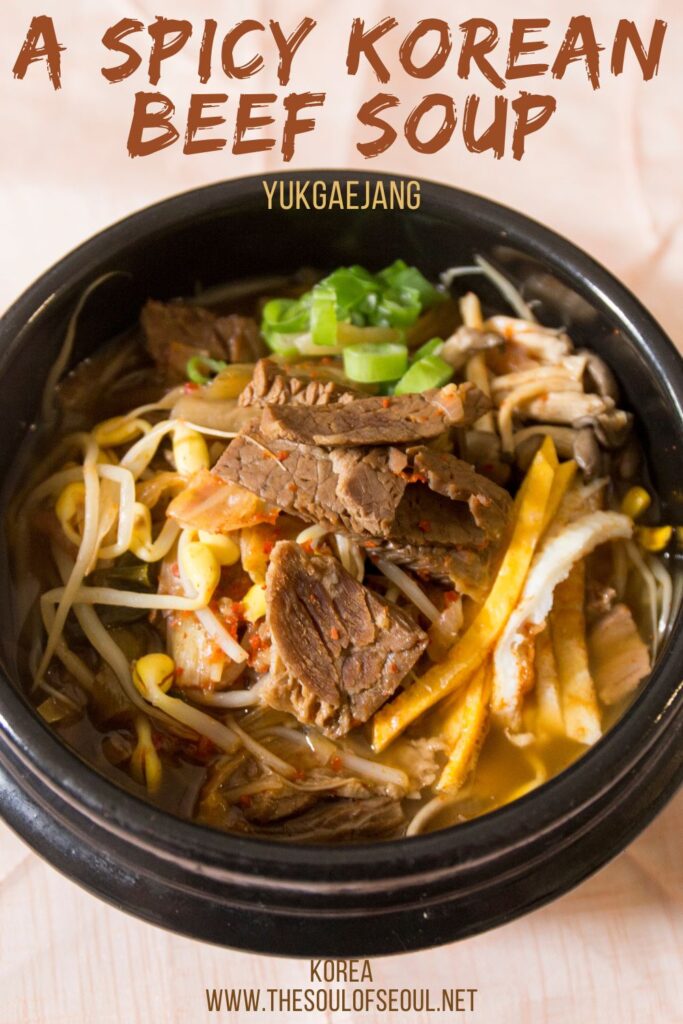Korean Cooking: How to make Yukgaejang
Last Updated on November 16, 2023
Yukgaejang (육개장) is a Korean beef and veggie stew that I manage to forget that I like before being reminded that I liked it multiple times a year. It’s a classic dish in any Korean household and after we’d gone out to eat it quite a few times in the past few weeks, I decided to try and make it myself. After having good experiences with Korean side dishes, my confidence was high to try another soup.
If you like Korean food with a spicy kick, this is a good soup to learn how to make but also, it’s pretty palatable for people that aren’t so good with spicy food. You can tamp down the spice on it and it’s still very delicious.
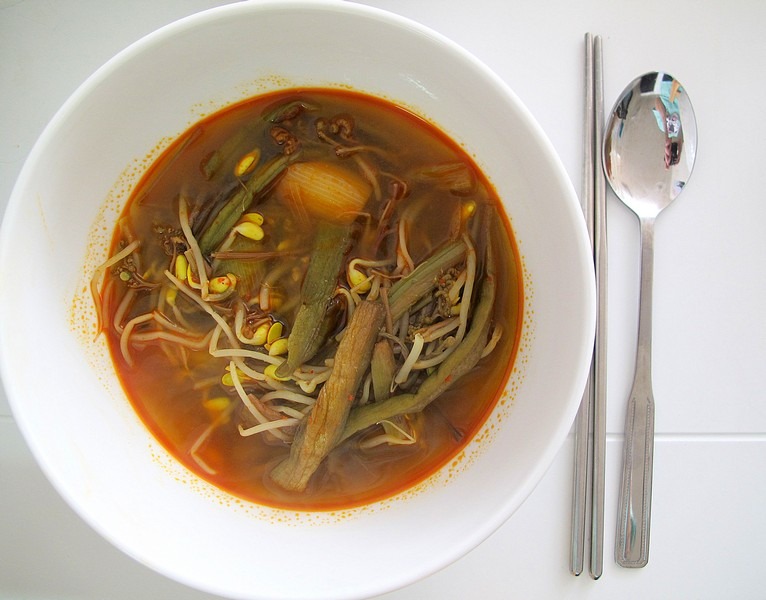
(This post contains affiliate links, which means I receive a certain percentage of a sale if you purchase after clicking at no cost to you. Thank you for your support.)
Since I’m learning to cook Korean dishes, the way it works in our house is I find a recipe in English because usually if it’s in English it doesn’t assume that I know a lot. I take that recipe and then confer with my Korean husband who then confers with his mother.
As usual, I wrote everything down and then my husband called his mother to see if she had anything to add or change, and of course she did. Here’s what we ended up with for a hearty two servings of yukgaejang.

Ingredients:
Broth:
- 12 oz. Beef Brisket
- 1/4 Onion
- 1/2 Green Onion
- 6 Cups Water
Main Ingredients:
- 6 Tbs. Taro Stems (토란)
- 6 Tbs. Fernbrake (고사리)
- 6 Tbs. Bean Sprouts
- 2 1/2 Green Onion Stalks
Seasoning:
- 2 Tbs. Red Chili Flakes
- 2.5 Tbs. Sesame Oil
- 2 Tbs. Soy Sauce
- 1.5 Tbs. Minced Garlic
- 2 Tsp. Salt
- 2 Tsp. Pepper
Ingredients Notes
What is fernbrake?
This purple/brown vegetable might be new to you. It was new to me before I went to Korea. You’ll find it in yukgaejang as well as the more common bibimbap. It goes by a few other names including:
- Fern bracken
- Bracken fern
- Fernbrake
- Fiddlehead ferns
- Bracken fiddleheads
Fernbrake is edible racken, young shoots, that are usually gathered in April and May and sold fresh at that time. If you go to the market outside of Korea, you might see the dried version. Still good, you’ll just have to rehydrate it before you use.
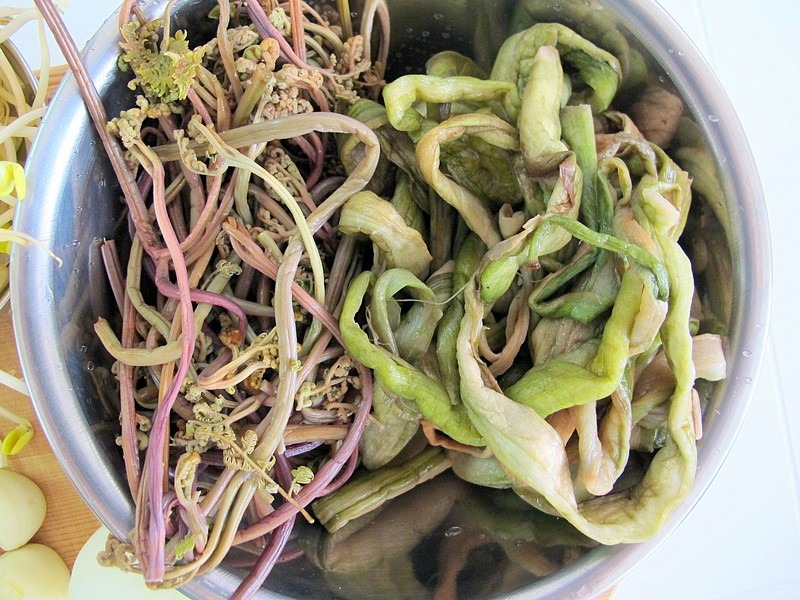
What are taro stems?
Taro stems are the young leaf stalks, or petioles, of the Taro plant. The plant most often known for its starchy tuber has much more to offer in its edible shoots, stems and leaves. The stems are typically from the young, new-growth leaves, though the stems of C. esculenta can be eaten when they are more mature. Taro stems are fibrous, so they must be peeled prior to preparing. The tough outer layer is removed to reveal a more tender stalk within. Taro stems have a slightly viscous texture reminiscent of okra.
Taro stem is available both fresh and dried. Koreans tend to eat the dried version. Taro stems are known to be a great source of calcium and fiber, and low in calories. They contain vitamins A and B6, and minerals such as thiamin, copper, potassium, niacin, zinc, and iron. They should not be consumed raw because that is toxic. It contains raphides which are small needle-shaped crystals made of calcium carbonate or calcium oxalate. Oxalates also compromise calcium levels in the body and may lead to the formation of kidney stones. Raphides, however, can be reduced by steeping taro roots in cold water overnight.

Directions
1. If you don’t have broth already prepared, combine the beef, onion, green onion and water in a pot. Bring the water to a boil and then let it simmer for 30 minutes to an hour. (If you have broth prepared already then move straight to the step 2, as per my mother-in-law who always has broth on hand.)
2. In a bowl, combine the prepared taro, fernbrake, beef and seasonings. If you already have broth, then your beef will be raw at this stage. If you didn’t have broth, then you should remove the beef to mix with the other ingredients at this point. Mix the ingredients by hand.



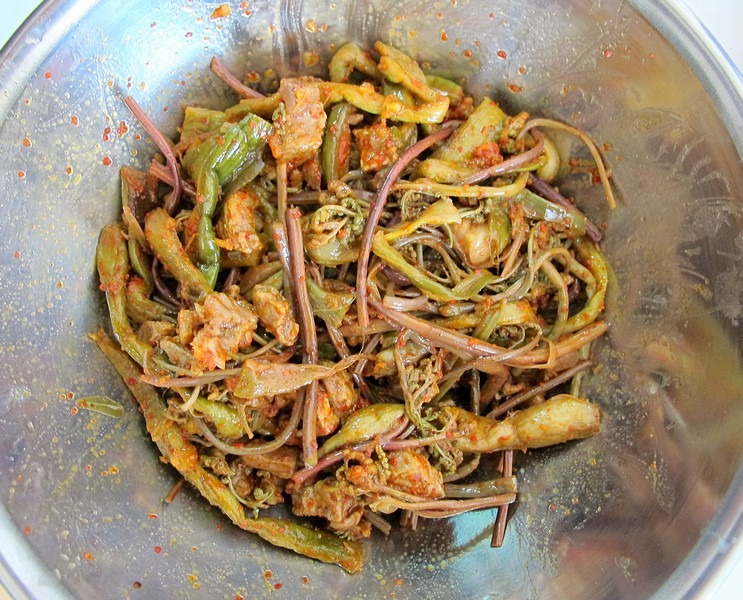
*In Korea, the taro and fernbrake will most likely be in the market already prepared for yukgaejang. When we went to get taro and then told the woman working that we needed fernbrake, she said, “Oh, you must be making yukgaejang.” If you live outside of Korea, or buy unprepared ingredients you’ll have to plan ahead.
The taro stems and fernbrake should be soaked in cold water for at least 6 hours (overnight is ideal). Before cooking, you should blanch them with a dash of salt and then rinse them under cold water and squeeze as much of the water out as possible. Cut the veggies into two inch pieces and make sure you cut the taro even further into thin strips as it will expand in the soup.

3. Take the mix from step two and place it in a pot and let it cook for 4 minutes before adding the broth. Bring the soup to a boil and then add your bean sprouts and green onions, turn it down and let it cook for at least 40 minutes.
4. Enjoy with rice and Korean side dishes.

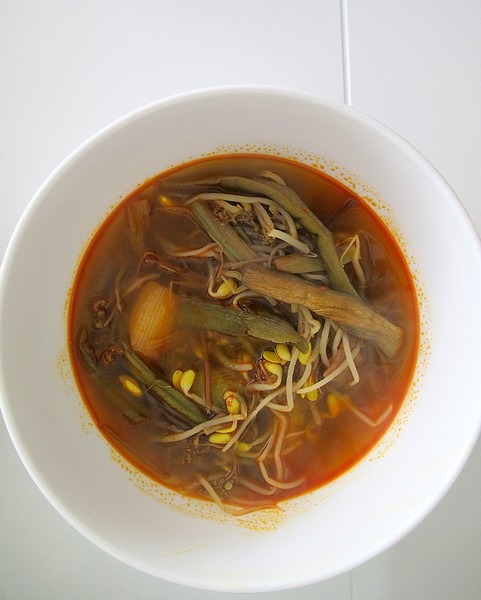
We were pretty happy with the soup, though next time I’ll try to give it more time in the pot to stew.
Did you like this post? Pin It!
